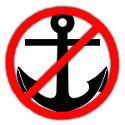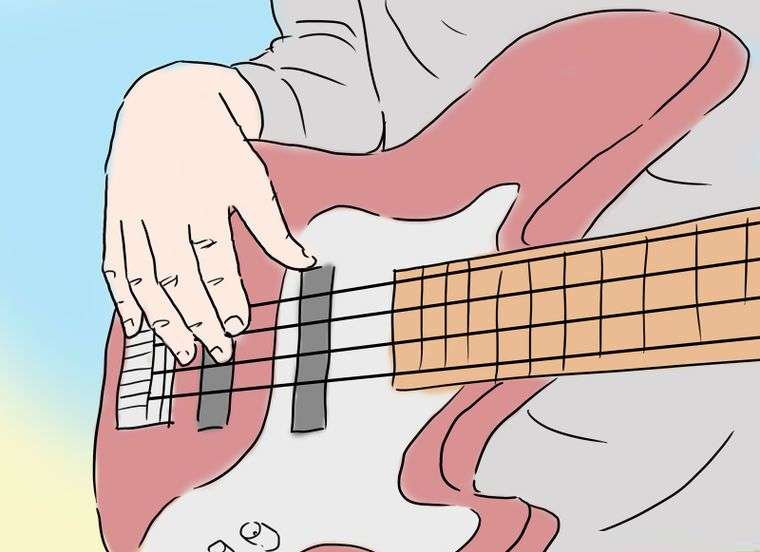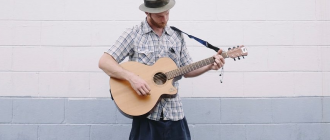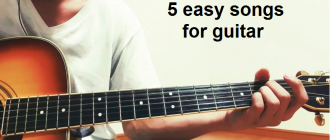Anchoring is touching part of your picking hand to the guitar body close to the strings, as opposed to an unanchored or floating style where the right hand does not touch the guitar. The fingers or palm that touch the guitar create a sort of pivot point, so you know where you are, and theoretically, so that your pick will have an easier time finding the right strings.
There are several types of anchors:
- Pinky: The pinky (and optional ring finger) touch the guitar body just under the top e string.
- Palm to bridge: Palm rests on the back of the bridge.

So why should I not anchor?
Short answer: Anchoring restricts movement and adds tension. Not anchoring, or floating, frees up your right hand and suddenly things get a lot more fluid. More better. More faster.
There are excellent guitarists who anchor, like John Petrucci, Marty Friedman, Joe Stump, Michael Angelo Batio, Steve Morse, etc. And those who don’t, like Paul Gilbert, Shawn Lane, etc.
The great debate: to anchor or not to anchor?
Proponents of anchoring say:
I’ve always done it that way. It feels natural. Look at all of these great players who anchor, are they wrong? It helps me know where I’m at and pick with accuracy.
“you lose accuracy if you don’t anchor.”
“I don’t know what you guys are talking about when you say there is strain, inaccuracy, and loss of speed (in regards to down-picking). I downpick much faster anchored (I don’t use my pinky, I rest my wrist on the bridge) than unanchored. I anchor when I play metal.”
Proponents of *not* anchoring say:
When I switched to an unanchored position I gained greater freedom of movement and there was less tension in my picking hand. Any part of your hand that is touching the guitar is restricting movement which slows you down.
Those who don’t anchor usually have their forearm resting on the edge of the guitar, but the pick hand is hovering over the strings and bridge. Some will let their palm or finger lightly touch the top of the bridge or strings, but never really use it as an anchor. Now when strumming, players will often palm mute, but this isn’t considered anchoring.
“i used to anchor. after reading a lot on the subject i decided to stop. it is a hard habit to break, but my speed went up 10 fold, there was LESS tension in my hand/wrist/arm, and my accuracy even improved. i would recommend not anchoring.”
“Ultimately it is NOT a matter of preference. If you don’t learn how to pick with your hand floating, unanchored on the guitar, you will be handicapped. […] without the crutch of anchoring your hand on the guitar, your picking will become more fluid and faster.
It is NOT less accurate. It only seems that way to begin with, because it’s more difficult to learn.”
The comments above are from the entertaining and enlightening ultimate-guitar.com forums thread here. Thanks to skydropsblue, edg, and others for their excellent comments.
Excellent video on the subject:
What does billybadaxe.com’s resident guitar hero Aaron say?
When I asked him, he laughed and said he doesn’t think about it. But I think I kind of planted a seed there because I got a very detailed email a little while later. He sat down with the guitar, played a few songs and watched himself playing. Oh, that’s how I do it! So what does Aaron do?
He doesn’t anchor… usually.
Though, he said, there were a few songs, Sweet Child of Mine intro, for example, where he did anchor to hit individual notes.
So should a beginner anchor or not?
Most newbie guitarists do anchor because it feels more stable, especially when trying to do lead/solo guitar. Picking those individual notes is tough at first and its natural to want to have some grounding or an anchor at first. Sort of like training wheels.
If you anchor, try to go unanchored and see if it helps you play guitar faster. Making the switch to an unanchored position is tough, and make take several months to get used to but it could take your playing to the next level.
Ultimately, try not to anchor. If you can train yourself to keep your picking had off the bridge and body of the guitar, it will really free you up. Your picking hand should be loose, and anchoring does the opposite. It’s a tense point. So you’ve got one or two tense fingers anchoring but the fingers holding the pick have to be relaxed. It’s tough to be tense and relaxed in the same hand!
How do I make the switch from anchored to un-anchored?
Start slow and give yourself time. Play as you normally do (anchored), but reserve maybe 1/4 of your practice time to playing unanchored. Even if it’s only 5 or 10 minutes a day. That is fine. Go slow! Don’t try to play anything difficult. Go back to the basics, play warm-up style scales that you know by heart. Play them methodically.
Slowly increase the amount of practice time devoted to floating. It should be a natural change that happens. Don’t put a lot of stress on yourself. Keep at it and don’t give up. It’s going to feel very strange at first–like your picking hand is out there on the end of a fishing pole and you have totally lost control and accuracy. That’s ok. Don’t give up. Look at it as a 3 to 6 month project that will eventually take your guitar playing to the next level.
I really hope this helps you concerning anchoring, especially if you are really trying to get better. Let me know what you think of anchoring in the comments below. –Dave







I started out anchoring, but naturally moved over to floating if you will without ever realizing it, this just felt more natural to me and I could never see how people could rest their picking hand on the guitar
It’s interesting. I can play fast and technical stuff – really fast. And I anchor on and off – it’s not consistent. Picking is just not something I’ve ever paid much attention to – it just happens – doing whatever is necessary. Kinda like I’ve always alternate picked and/or economy picked and whatnot without ever thinking about it (and then some day you read about it and you’re like, oh, that’s what it’s called, I’ve always done that). Having read debates like this I’ve been paying more attention and attempting to anchor less or not at all to see if it makes a difference but, but as stated, it’s a hard habit to break, especially after 30+ years of playing. Sometimes I think, I can already play ludicrously fast so maybe just stick with what works…but…it could be faster, cleaner, more efficiently done, and so on….so it’s an interesting topic to read about.
Regarding not anchoring the right hand, you never write with the hand “in the air”, do you? So why would you like to compromise the precision achieved from anchoring when playing the guitar?
I am a very old picker have been playing from 10 yrs of age to now 69 yrs (very long time) developed dystonia starting about 15 -20 yrs ago, always used anchors, bridge muting or just a little finger etc, always felt more stable, but in the old days had non of the tutoring you have today so largely self tort as one of the mid 50’s pioneers but believe I developed some very bad habits ending with dystonia I am adopting the floating /dead, hand approach and it makes a very big difference and my fingers don’t seem to want to cramp up or go spastic, arm like wise I’m thinking if I had been shown correct technique many years ago I might not have developed dystonia So listed to the logic of floating hand / speed etc, there is more than one might think in this message or analysis and might help some avoid developing dystonia? Might for some even be akin to “stop smoking before the damage is dome” anyway this technique is showing great promise for me, Thanks for the effort and research you have done, my comments might help some benefit as well Don’t write this off a just another crazy idea, I think there’s much more to it than you might at first think Kind Regards Geoff
Joe Satriani, Steve Vai, Yngwie Malmsteen, John Petrucci, Alexi Laiho, and Michael Angelo Batio all use anchoring as an integrated part of their picking technique, just to name a few off the top of my head. But, of course, if *you* say it’s a bad newbie technique that should be avoided if you wanna be, like, REALLY PRO, random guy on the internet, it simply *must* be true, because *clearly* these guys haven’t got the faintest idea about how to play the guitar …
Boy Howdy! Your comment says what I’ve always thought (hoped, might be a better word). I’ve been playing for over 50 years and occasionally felt a little insecure about my picking technique so I always pay attention to my guitar heros’s right hand. What I do is to do both techniques simultaneously (kind of). I anchor my my palm “lightly” while brushing the top of the guitar with my fingers like an insect with antennas, not really planted per say. It feels completely natural to me. I’m old school where you do what works for you. But, I admit, that using a floating hand sounds cool and a ton of exceptional players do just that.
I usually anchor when i play the lower strings but i try just to lay my pinky on the pickguard without really touching it. It feels more comfortable than floating where i struggle to keep my fist closed. Sometimes i float my hand (depending on the lick), whichever feels more natural. The key is being relaxed.
I feel like both side have very good points (anchoring for precision, floating for dexterity/much less tension.) I have tried both and ultimately just naturally anchor. This is an interesting topic because its one of those things most musicians “just do.” Over the years I have tried very hard to improve my down picking speed and control but I just can’t seem to get my wrist in the proper comfortable position for fast down picking. It ends up kinked in a strange way that is very uncomfortable. Any tips would be greatly appreciated. PS Comments like those from KC should be relegated to the dregs of the internet like you tube. No need for that crap. The author took time to raise discussion on a good topic. It was well presented and was in no way seen (from me anyway) as “YOU’RE WRONG!” So chill out
thanks for the reply, Robert. yep, it’s kind of a hot button topic among guitarists! find the style you like and roll with it.
Robert, as far as down picking speed goes, have you tried isolating just the picking hand while the fret hand just mutes the strings? just work on the downstroke without worrying about the fret hand. sometimes when you work on just one hand you can see where you are going wrong and work some things out. hope that helps!
I’ve been playing for 40 years. I ran across a website where the expert says you must anchor and how anchoring will increase accuracy. I have tried it and it feels like I have handcuffs on. I can’t really control low E open string noise effectively using anchoring. I have adopted a style where I use the forearm of my picking hand to control the E, A, D (to a point) with a little help from the chording thumb and, well, you guys know the routine. I also like to move around over the different pickups to get different sounds. Also, grapping the whammy bar temolo) is awkward to me when trying to anchor on my picking hand on the bridge (for lack of better word).
You seem to forget that muting lower strings is CRUCIAL on an electric guitar, especially if you’re using gain. But I suppose and hope you don’t consider this light muting “anchoring”.
The key point of a “floating” technique is the following: “Some will let their palm or finger lightly touch the top of the bridge or strings, but never really use it as an anchor.” On an electric guitar, you simply have to mute lower strings in some way, in order to stop them from ringing. Note that this is done with a MOVABLE hand that follows the string you’re playing. It’s not any kind of firm anchor, once again. Regarding picking in general, I’m finally beginning to see the light This is my approach: I keep my hand extremely relaxed to the point of dropping from the wrist. I use a small rotating motion to pluck the string. It should ideally feel the same way as when you twist your hand in the air. I move my hand up and down the bridge in order to keep the posture of the hand EXACTLY the same on ALL strings. This is by far the most relaxed way of picking.
Well I just discovered that I never anchored. And now I move my hand a little more on the palm muting so I can down stroke much faster. Truly I tried anchoring and it does impede your picking hand freedom a lot. The forearm on the guitar body should give plenty of anchor, using the hand will only add too much of it. Anchoring the hand makes it difficult to sweep the strings since you might have to move up and down with your wrist.
Usually people with big palms/chunky fingers have to anchor to play fast. It is all about proportions of your fingers, palm, wrist, hand muscles weight etc This is why many great guitar players anchoring / not anchoring It is very wrong to recommend to everyone one method.
That’s awesome that a floating-hand technique worked for you, but why is your preference gospel? Plenty of greats have used anchoring to their advantage. Michael Angelo Batio has specifically stated that anchoring has been a boon in his playing. I’ve observed the picking techniques of tons of guitarists. Nobody is quite the same. Some people use only their wrist, some use their fingers, some rotate their entire forearm. Some anchor with one finger, some with two, some not at all. If there is a particular technique that makes or breaks a great guitarist, it’s definitely not anchoring.
nice writeup. i found this because i was curious if i’m finally moving into “expert” territory. similar to what jake stated, i am in the process of naturally moving over to the floating technique. i have been playing a couple hours a day (probably 3 on average) for the first ~17 months, and the last couple months 5 hours a day. i probably had a few hundred hours before these past 19 months, so my total is probably over 2000 hours at this point. i started anchoring on the bridge (v bad, i know) and over the past 45 days, that anchor moved from the bridge to the tailpiece, and when i really wanted to play owner of a lonely heart’s main rhythm, or many different parts of paradise city, i found that my hand started to float (“pinky anchor”). i am skipping the pinky anchoring transition and opting to tough it out with having my hand float. one thing i will say is, yes speed is one thing, but i find if you make this transition naturally, your accuracy does go up. and the notes sound much cleaner for me, since i am at the start of the last leg for strumming hand position, i find that the most noticeable improvement is the *continuity* of my strums. for owner of a lonely heart, the rhythm isn’t tricky in terms of fretting, but when it comes to the continuity i found that the floating hand really allowed me to keep it going. the reason it has taken me this long is i originally have a background in computers, and used the computer quite a bit from 1997 – ~2013. i would wager my average hours per day were 10. as a result, my strumming hand (right arm) developed a nasty slouch from resting my entire forearm on the desk when using the desktop (it made prolonged usage of the mouse much easier, but severely compromised my posture and essentially lead to me having no back muscle). one thing i will say about learning guitar is that, between the tough weeks where you’d feel there was no progress, followed by weeks where you suddenly notice improvement, it has done wonders for my body and i highly recommend it for that part alone. my shoulders are nearly fixed thanks to playing while standing up. i am so happy i kept going all those times. i find that having my thumb at the top of the fret board for *ANYTHING* is so uncomfortable, so you can imagine how much more pain i went through. in the end i am very comfortable with the way i play, but i acknowledge that is likely very unusual when compared to others. and that’s another thing: play your way. that is, play the way that you find most comfortable and DON’T let anyone tell you how to play. if you can anchor and get speed and accuracy: GREAT! if you can’t, just keep playing and eventually some of your favourite songs should help you figure it out on your own. if i looked at videos of Tony Iommi or the likes, and tried to use them as my reference, i would likely be a very bad player compared to the kind of player i am now. that is the toughest thing about learning this instrument: accepting that we will all play it a little (or in my case, very) differently.
Good points. Yep, in the end it’s all about personal preference. Don’t be afraid to test new stuff out. Wow. Five hours of practice a day!
Just stumbled upon this interesting conversation, because I guess I must be an ‘anchorer’ and I some times have trouble with bridges roughing up my palm/wrist and wanted to know what guitars have the most comfortable, non spiky bridges. I think I anchor mainly because, as others have mentioned, I feel I can control the amount of muting going on more easily. However, as a more general comment I would say that one of the biggest glories of the guitar must surely be that different people approach it differently and squeeze something unique out of it. I love that you can spot who is playing something almost immediately (step up BB King) from their style. I’m not saying we shouldn’t experiment and all this ‘floating = more flexible picking’ does sound interesting, but it also possibly assumes that a fast clean pick is what everybody is after – some times a bit of digging in and sloppiness adds more expression than a thousand neatly and rapidly picked notes (step up Neil Young) – so I say lets celebrate people exploring the many different ways that you can play the guitar!
Thanks for all of the comments here. In the end it all boils down to personal preference. Can you play faster, better, cleaner with an anchored right hand position? Or maybe you’ve been anchoring for so long you can never go back. Or maybe you hadn’t even considered it! Hallam’s points above are spot on. Main thing is, do what works for you and don’t be afraid to experiment. By changing your hand position you might unlock some speed you didn’t know you had.